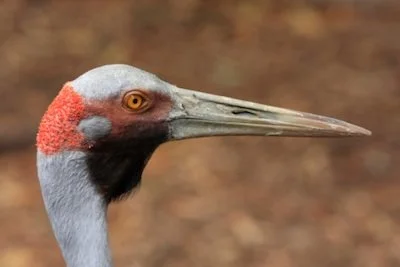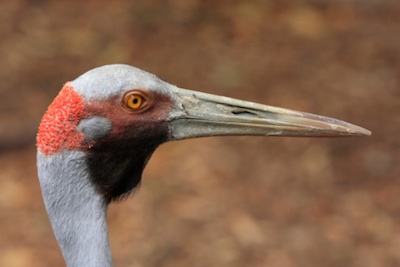Brolgas are tall birds that live in wetlands.
They have long legs.
They have grey feathers and a patch of red skin on their heads.
They eat grass, roots, frogs and small lizards.
A male and female dance together.
Brolgas are Australian birds that belong to the family of birds known as cranes.
Brolgas in flight © Getty images
Cranes are a family of tall wading birds that look a bit like herons, and are found all over the world. However, cranes have a patch of unfeathered skin on their heads, and herons do not.
There are two kinds of crane in Australia: the brolga and the sarus. The sarus crane is the tallest of the crane family, at about 1.8m tall.
Habitat and Distribution (Where it is found)
Like all cranes, a brolga's head is not feathered. ©Getty Images
The brolga is found in the northern and eastern parts of Australia, in wetland areas. They live in large groups called flocks, sometimes as large as 1000 birds. Each family in the flock is led by a male.
Appearance
The female brolga grows to be 95-100 cm tall, and the male 110-125 cm tall.
Brolgas have long grey legs. They have a pale grey body with a patch of red skin on the back of their heads, running from eye to eye. Under their chins there is a dark dewlap, or hanging skin. When they spread their wings, the span is 2 metres from tip to tip.
Diet
Brolgas eat grass, roots, insects, frogs and small reptiles. At times when their habitat dries out, the birds fly very far to find food.
Life Cycle
Brolgas dance with each other before mating. ©Getty images
Brolgas stay with the same partner for life. The brolgas are most famous for their mating dance. The breeding season is in November or December. A pair of brolgas spread their wings and leap and dance gracefully before mating.
After mating, the female brolga lays 2 eggs in a nest. The nest is a big platform of grass and reeds, about one and a half metres across. Both parents share the task of sitting on the eggs, which hatch after about 30 days. After this, both parents share the task of feeding the chicks.
Both male and female brolgas feed and care for their chicks. © Getty images
Conservation Status and Threats
In New South Wales they are classified as Vulnerable, but are listed as of Least Concern throughout the northern part of Australia.
Brolga © Getty Images
One of their main threats is habitat loss through the draining of wetlands, which reduces the amount of freshwater habitat.
The birds and their eggs are preyed upon by the fox, an animal introduced to Australia that has caused a great deal of harm to populations of many native animals.
Legend
An ancient legend of some Aboriginal peoples tells of a beautiful young woman who always danced instead of working. Her name was Bralgah. She was turned into a tall, slender bird. The complicated dance of the brolga is imitated by Aboriginal peoples in some of their dances.
Watch a video of part of the brolga dance here:
http://www.australian-information-stories.com/brolga.html
Read more about brolgas here
https://www.zoo.org.au/werribee/animals/brolga






